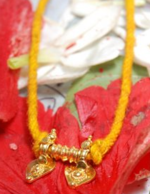| Revision as of 08:30, 27 July 2022 editTunacco53 (talk | contribs)55 editsNo edit summary← Previous edit | Revision as of 08:41, 27 July 2022 edit undoTunacco53 (talk | contribs)55 editsNo edit summaryNext edit → | ||
| Line 1: | Line 1: | ||
| '''Pushpaka Brahmin''' is a generic term that refers to a group of |
'''Pushpaka Brahmin''' is a generic term that refers to a group of certain ] ] castes in ].<ref>{{cite book|url=https://books.google.com/books?id=JmjaAAAAMAAJ&q=puspakar |title=Polity, Society, and Women: With Special Reference to Travancore, 1700-1900 A.D. |first=Suma |last=Rose |publisher=Carmel International Publishing House |year=2004 |page=217 |isbn=9788187655374 |accessdate=2013-04-30}}</ref> | ||
| The term ''Pushpaka'' applies primarily to a caste known as ] (or Pushpakan Unni) in South Kerala (Travancore). Pushpakas were assigned the job of tending flowers and making garlands in the Hindu temples |
The term ''Pushpaka'' applies primarily to a caste known itself as ] (or Pushpakan Unni) in South Kerala (Travancore). Pushpakas were assigned the job of tending flowers and making garlands in the Hindu temples. They were also given rights to teach sacred texts and Sanskrit language in the Pathasalas associated with Hindu temples. ]s in Central and North Kerala are often referred to as Pushpakas owing to their cultural similarity with Pushpakas in South Kerala. In addition to these two castes, the term ''Pushpaka Brahmin'', in a wider sense, applies to certain other Ambalavasi castes like Theeyatt Unnis, Kurukkals, Puppallis, Pilappallis, Nambidis and Daivampadis. All these castes are associated with temple related jobs and have many socio-cultural similarities. | ||
| ] | ] | ||
| ==Community welfare== | ==Community welfare== | ||
| Nowadays, Pushpaka Brahmins are reluctant to cling to their traditional professions like priesthood,<ref>{{cite news |title=62 Priests to Travancore Devaswam Board |url=https://www.manoramaonline.com/news/kerala/06pta-tdb-poojari-list.html# |publisher=Malayala Manorama|language=Malayalam}} Quote:തിരുവിതാംകൂർ ദേവസ്വം ബോർഡ് ക്ഷേത്രങ്ങളിലേക്ക് 62 ശാന്തിക്കാർ കൂടി - നായർ, വാരിയർ, മാരാർ, പുഷ്പകർ എന്നീ വിഭാഗങ്ങളിൽനിന്ന് ആരുമില്ല.</ref> | Nowadays, Pushpaka Brahmins are reluctant to cling to their traditional professions like priesthood,<ref>{{cite news |title=62 Priests to Travancore Devaswam Board |url=https://www.manoramaonline.com/news/kerala/06pta-tdb-poojari-list.html# |publisher=Malayala Manorama|language=Malayalam}} Quote:തിരുവിതാംകൂർ ദേവസ്വം ബോർഡ് ക്ഷേത്രങ്ങളിലേക്ക് 62 ശാന്തിക്കാർ കൂടി - നായർ, വാരിയർ, മാരാർ, പുഷ്പകർ എന്നീ വിഭാഗങ്ങളിൽനിന്ന് ആരുമില്ല.</ref> | ||
Revision as of 08:41, 27 July 2022
Pushpaka Brahmin is a generic term that refers to a group of certain Hindu Brahmin castes in Kerala.
The term Pushpaka applies primarily to a caste known itself as Pushpaka (or Pushpakan Unni) in South Kerala (Travancore). Pushpakas were assigned the job of tending flowers and making garlands in the Hindu temples. They were also given rights to teach sacred texts and Sanskrit language in the Pathasalas associated with Hindu temples. Nambeesans in Central and North Kerala are often referred to as Pushpakas owing to their cultural similarity with Pushpakas in South Kerala. In addition to these two castes, the term Pushpaka Brahmin, in a wider sense, applies to certain other Ambalavasi castes like Theeyatt Unnis, Kurukkals, Puppallis, Pilappallis, Nambidis and Daivampadis. All these castes are associated with temple related jobs and have many socio-cultural similarities.

Community welfare
Nowadays, Pushpaka Brahmins are reluctant to cling to their traditional professions like priesthood, adhyapanam (teaching) in Pathasalas, malakettu (garland making), vilakkeduppu (lamp bearing). Due to low income from these professions. Sree Pushpakabrahmana Seva Sangham is an organisation working for the welfare of Pushpaka Brahmin castes.
References
- Rose, Suma (2004). Polity, Society, and Women: With Special Reference to Travancore, 1700-1900 A.D. Carmel International Publishing House. p. 217. ISBN 9788187655374. Retrieved 2013-04-30.
- "62 Priests to Travancore Devaswam Board" (in Malayalam). Malayala Manorama. Quote:തിരുവിതാംകൂർ ദേവസ്വം ബോർഡ് ക്ഷേത്രങ്ങളിലേക്ക് 62 ശാന്തിക്കാർ കൂടി - നായർ, വാരിയർ, മാരാർ, പുഷ്പകർ എന്നീ വിഭാഗങ്ങളിൽനിന്ന് ആരുമില്ല.